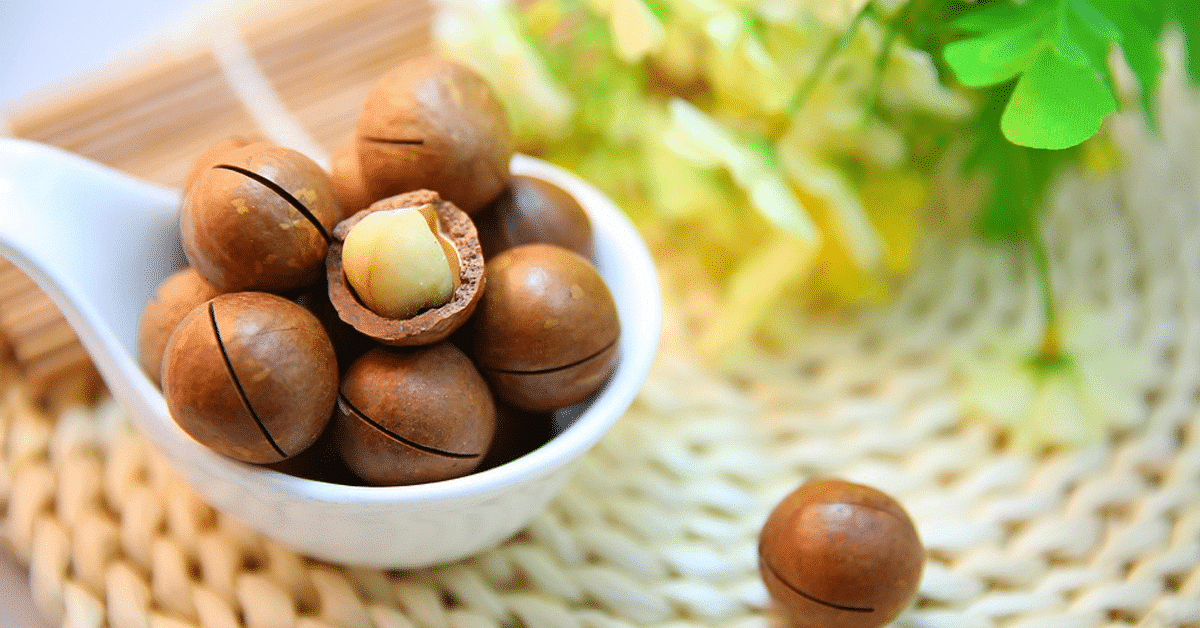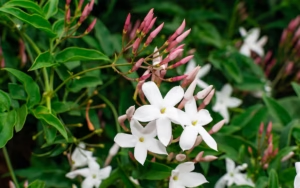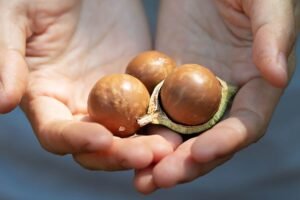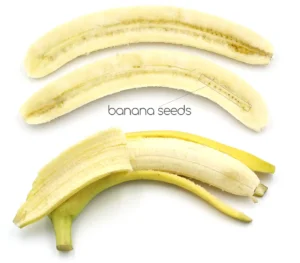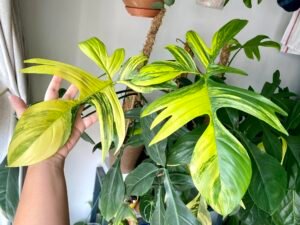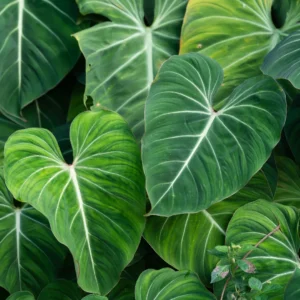Macadamia nut trees, known for their buttery and nutrient-rich nuts, are a favorite among gardeners and farmers in warm climates. Native to Australia, these trees are not just prized for their produce but also for their lush foliage and ornamental value. Whether you’re growing them in your backyard or on a larger scale, caring for macadamia nut trees requires understanding their needs, from planting to protecting against pests and diseases. This guide will provide all the information you need to grow a thriving macadamia nut tree.
Quick Overview
| Feature | Details |
|---|---|
| Common Name | Macadamia Nut Tree |
| Botanical Name | Macadamia integrifolia or Macadamia tetraphylla |
| Family | Proteaceae |
| Plant Type | Evergreen Tree |
| Mature Size | 30–40 feet tall, 15–20 feet wide |
| Sun Exposure | Full Sun |
| Soil Type | Well-drained, sandy or loamy soil |
| Soil pH | Slightly acidic to neutral (5.0–6.5) |
| Hardiness Zones | 9–11 |
| Native Area | Australia |
| Toxicity | Toxic to dogs and cats |
Planting and Transplanting Macadamia Nut Tree
Planting a macadamia nut tree is the foundation of its health and productivity. Proper location, soil preparation, and timing ensure the tree establishes a strong root system and grows vigorously.
Choosing the Right Location
- Sunlight: Macadamia trees thrive in full sun. Choose a location that receives at least 6–8 hours of direct sunlight daily.
- Spacing: Ensure enough space between trees (about 25–30 feet) to accommodate their mature size and allow for air circulation.
- Protection: Avoid low-lying areas prone to frost. If you’re in a windy region, plant near a windbreak to protect young trees.
Soil Preparation
- Drainage: Well-draining soil is essential to prevent root rot. Amend heavy clay soils with sand or compost to improve drainage.
- Fertility: Enrich the soil with organic matter, such as aged manure or compost, to provide essential nutrients.
- pH Level: Test the soil pH and adjust if necessary. Adding sulfur can lower pH, while lime can raise it.
Planting Steps
- Dig a hole twice the width and the same depth as the tree’s root ball.
- Gently remove the tree from its container and loosen the roots.
- Position the tree in the hole, ensuring it sits at the same depth as it was in the container.
- Backfill with soil, tamping it down lightly to eliminate air pockets.
- Water thoroughly and mulch around the base to retain moisture.
Transplanting Tips
- Timing: Transplant during late winter or early spring when the tree is dormant.
- Care: Handle the root ball carefully to minimize damage. Ensure the new location meets all growth requirements.
Macadamia Nut Tree Care
Once planted, macadamia nut trees need consistent care to thrive. Their maintenance involves watering, fertilizing, and protecting them from environmental stressors.
Watering
- Newly planted trees require regular watering to establish roots. Water deeply once or twice a week.
- Mature trees are drought-tolerant but produce better yields with consistent moisture. Use a drip irrigation system for efficient watering.
Fertilizing
- Apply a balanced, slow-release fertilizer (e.g., 10-10-10) in early spring and mid-summer.
- Add trace elements like boron, zinc, and manganese, which macadamias often require.
Mulching
- Spread organic mulch (like bark or straw) around the base to conserve moisture, suppress weeds, and regulate soil temperature.
- Keep mulch a few inches away from the trunk to prevent rot.
Temperature and Humidity
- Ideal temperatures are between 60°F and 85°F.
- Avoid frost, as it can damage leaves and flowers. Use frost blankets or heaters in colder areas.
Types of Macadamia Nut Tree
There are two primary species of macadamia nut trees cultivated for their nuts:
- Macadamia integrifolia
- Produces smooth-shelled nuts.
- Prefers tropical climates.
- Grown extensively in Hawaii and parts of Australia.
- Macadamia tetraphylla
- Produces rough-shelled nuts.
- Better suited to cooler, subtropical climates.
- Can tolerate slightly acidic soils.
Pruning
Pruning is essential for maintaining the tree’s health, shape, and productivity.
When to Prune
- Late winter or early spring is the best time to prune.
- Avoid pruning during flowering or fruiting to prevent stress.
How to Prune
- Remove Dead Wood: Cut away dead, damaged, or diseased branches to prevent the spread of pests and diseases.
- Shape the Tree: Maintain an open canopy to allow sunlight penetration and air circulation.
- Control Size: Trim back excessive growth to keep the tree manageable, especially in small gardens.
Propagating Macadamia Nut Tree
Propagation is typically done through grafting, as seeds often take years to produce nuts and may not retain the parent tree’s qualities.
Seed Propagation
- Plant fresh seeds in a pot with well-draining soil.
- Keep the soil moist and place the pot in a warm, sunny location.
- Germination can take up to 6–12 weeks.
Grafting
- Take scion wood from a healthy, productive tree.
- Graft it onto a seedling rootstock for faster growth and reliable nut production.
- Protect the grafted area with grafting tape and monitor for successful union.
Potting and Repotting Macadamia Nut Tree
Growing macadamia nut trees in pots is ideal for those with limited space.
Pot Selection
- Use a large, sturdy pot with good drainage holes.
- Choose a potting mix designed for trees or citrus plants.
Repotting Steps
- Repot every 2–3 years as the tree outgrows its container.
- Gently remove the tree, prune the roots slightly, and place it in a larger pot.
- Refill with fresh soil and water thoroughly.
Overwintering
Macadamia nut trees are sensitive to cold temperatures. Protect them during winter to ensure they survive and thrive.
Outdoor Trees
- Apply a thick layer of mulch around the base to insulate roots.
- Cover young trees with frost blankets during cold spells.
Potted Trees
- Move potted trees indoors or to a sheltered location when temperatures drop below 50°F.
- Ensure they receive adequate sunlight, even indoors.
Common Problems With Macadamia Nut Tree
Nutrient Deficiencies
- Symptoms: Yellowing leaves, stunted growth.
- Solution: Apply a fertilizer with micronutrients like zinc, boron, and manganese.
Root Rot
- Symptoms: Wilting, discolored roots.
- Solution: Improve soil drainage and avoid overwatering.
Common Pests & Plant Diseases
Pests
- Macadamia Nut Borer: Causes damage to nuts. Use insecticides or natural predators.
- Scale Insects: Appear as small, waxy bumps on leaves. Treat with horticultural oil.
Diseases
- Phytophthora Root Rot: A fungal disease caused by waterlogged soil. Ensure proper drainage.
- Anthracnose: Causes leaf and nut lesions. Use fungicides and prune affected areas.
How to Get Macadamia Nut Tree to Bloom
Macadamia nut trees typically bloom after 5–7 years. To encourage flowering:
- Ensure consistent sunlight exposure.
- Apply phosphorus-rich fertilizer to promote flower development.
- Avoid over-pruning, which can delay blooming.
FAQ
How long does it take for a macadamia nut tree to bear fruit?
It can take 5–7 years for a macadamia nut tree to produce its first crop of nuts.
Can I grow macadamia nut trees indoors?
Yes, but it’s challenging. Indoor trees need ample sunlight, proper humidity, and regular care.
Are macadamia nuts toxic to pets?
Yes, macadamia nuts are toxic to dogs and cats and should never be given to them.
Read also: How to Grow and Care for Florida Beauty


